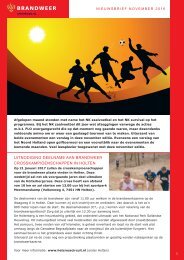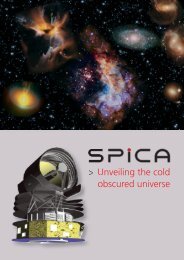SRON_Spectrum_2016
You also want an ePaper? Increase the reach of your titles
YUMPU automatically turns print PDFs into web optimized ePapers that Google loves.
indicate that a planet is moving in front of<br />
the star.<br />
Many exoplanets have already been discov -<br />
ered using this transit method, for example<br />
by the space telescope Kepler. However, the<br />
PLATO mission will go a step further. “Kepler<br />
can only map a very small piece of the sky.<br />
PLATO will examine almost the entire sky so<br />
that all bright stars can be studied at the<br />
same time,” says Min. “Furthermore PLATO<br />
will not just measure for a few months but<br />
for several years. That will make it possible<br />
to find exoplanets that take longer to orbit<br />
around their star. Such as the earth which<br />
takes one year to orbit the sun.”<br />
<strong>SRON</strong> is expected to contribute to the PLATO<br />
mission by providing test facilities. Min: “The<br />
34 telescope cameras must all be tested at<br />
extremely low temperatures for factors such<br />
as stability and precision. We want to carry<br />
out some of these tests at the institute in<br />
Groningen.”<br />
Eventually astronomers will collate all of the<br />
values measured in a catalogue of thousands<br />
of exoplanets. They will then be able to use<br />
this to determine which exoplanets merit fur -<br />
ther research. The next step will be to es tab -<br />
lish the exact composition of these plan ets’<br />
atmospheres. The ARIEL mission (Atmo spheric<br />
Remote-Sensing Infrared Exoplanet Large<br />
sur vey) has been proposed for that. In the<br />
first half of 2017 the ESA will have to make a<br />
choice between this and two other proposed<br />
missions. If the ARIEL mission is selected then<br />
it will be started in about 2025.<br />
Hot Jupiters and super earths<br />
“I think the time is ripe for a mission like<br />
ARIEL,” says Min. “There are already a lot of<br />
missions to identify exoplanets but few of the<br />
planets found are being characterised. This<br />
requires telescopes that can remain stable<br />
over a long period of time like the James<br />
Webb Space Telescope that will become oper -<br />
ational in 2018. However exoplanets will be<br />
Proposal for the ARIEL telescope (ESA).<br />
just one of the things it observes. Hopefully<br />
ARIEL will get the go-ahead and observe only<br />
exoplanets.”<br />
In the case of the ARIEL mission a telescope<br />
onboard a space probe will carry out mea -<br />
surements on about 500 exoplanets over a<br />
period of 3.5 years. Those will mainly be the<br />
There are many missions<br />
to identify exoplanets<br />
but few exoplanets are<br />
being characterised<br />
‘hot Jupiters’ and ‘super earths’: large planets<br />
with a temperature of several hundred<br />
degrees Celsius. “Only such planets have<br />
atmospheres thick enough to be measured,”<br />
says Min. If the ARIEL mission goes ahead<br />
and it uses European detectors then engineers<br />
from <strong>SRON</strong> will contribute by developing the<br />
readout electronics. <strong>SRON</strong> scientists are also<br />
eagerly looking forward to the moment that<br />
the results from this and the PLATO mission<br />
can be analysed. Min: “We still know little<br />
about the cloud formation on exoplanets.<br />
In addition, the measurements will give insight<br />
into the formation of planets. More data<br />
are needed to be able to statistically demonstrate<br />
where and how planets are formed in<br />
general.”<br />
Extraterrestrial life<br />
A better understanding of the formation and<br />
evolution of planets should also lead to an<br />
answer to the ultimate question concerning<br />
extraterrestrial life. According to Min, how -<br />
ever, the PLATO and ARIEL missions will get<br />
nowhere near to answering these questions.<br />
“We cannot characterise planets as small as<br />
earth yet. We can characterise super earths<br />
but only if they are located quite close to the<br />
star. As a result of that they are too warm to<br />
support life.”<br />
Min is cautiously optimistic about the chance<br />
that we are not alone. “Up until now everything<br />
that is physically possible also occurs in<br />
the universe. Billions of earth-like planets are<br />
therefore expected to exist. Then we need to<br />
ask: Is the chance of life evolving on such a<br />
planet greater than one in a billion? We don’t<br />
know and we are currently doing the statistics<br />
on a sample of one. That number needs to be<br />
bigger.”<br />
The question about life will therefore remain<br />
unanswered for the time being. Hopefully<br />
future missions will be able to demonstrate<br />
whether our solar system is commonplace or<br />
completely unique.<br />
YANNICK FRITSCHY<br />
11<br />
<strong>SRON</strong> <strong>Spectrum</strong>






